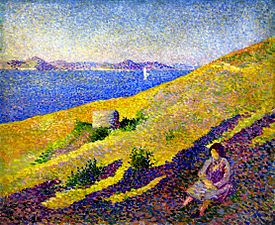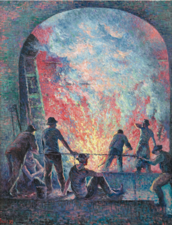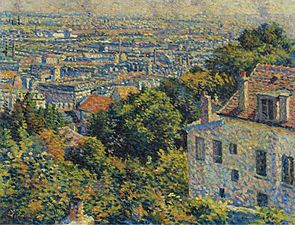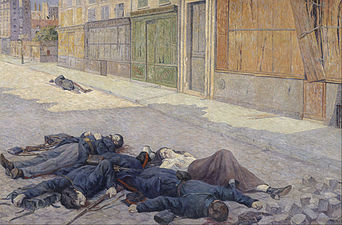Maximilien Luce
Maximilien Luce | |
|---|---|
 | |
| Born | Maximilien-Jules-Constant Luce 13 March 1858 Paris, France |
| Died | 6 February 1941 (aged 82) Paris, France |
| Known for | Painting |
| Movement | Neo-Impressionism |

Maximilien Luce (13 March 1858 – 6 February 1941) was a prolific French
Early life and education

Maximilien-Jules-Constant Luce was born on 13 March 1858 in Paris. His parents, of modest means, were Charles-Désiré Luce (1823–1888), a railway clerk, and Louise-Joséphine Dunas (1822–1878). The family lived in the Montparnasse, a working-class district of Paris. Luce attended school at l'Ecole communale, beginning in 1864.[1][2]
In 1872, the fourteen-year-old Luce became an apprentice with
Luce began working in the studio of
Work

Luce spent four years in the military, starting in 1879, serving in Brittany at Guingamp. The next year, he received a promotion to corporal, and he became friends with Alexandre Millerand, who, in 1920, assumed the office of President of France. In 1881 he requested the restoration of his lower rank of soldier, second class. Carolus-Duran used his influence to get a transfer for Luce to Paris barracks. His stint in the military came to a close in 1883.[3]
The prevalence of the new zincography printing process rendered xylography nearly obsolete as a profession.[1] When the opportunities for employment as an engraver became scarce, Luce shifted his focus to painting full-time in about 1883.[3]
Gausson and Cavallo-Péduzzi introduced Luce in about 1884 to the

With the exception of the years 1915 to 1919, Luce exhibited in every show at Les Indépendants from 1887 until he died in 1941,
In the spring of 1892 Luce traveled with Pissarro to London. Later that year, he visited Saint-Tropez with Signac, and in the summer of 1893, he went to Brittany.[1]
Starting near the early part of the twentieth century, his identification with the Neo-impressionists began to disappear, as he became less active politically, and his artistic style shifted from Neo-impressionism, and he resumed painting in an Impressionist manner.[1][9] Some of his paintings during this period depicted wounded World War I soldiers arriving from the battlefront to Paris.[6]
Luce depicted a diverse range of subjects in his works over a long career. He most frequently created
Anarchism
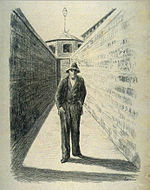
Luce aligned with the Neo-impressionists not only in their artistic techniques, but also in their political philosophy of
Luce's choice of subject matter for his art was often rooted in his political beliefs. Through his paintings, he passionately demonstrated empathy and fellowship with the proletariat.[1]
Family

In 1893, Luce met Ambroisine "Simone" Bouin in Paris. She became his model, companion,[13] common-law wife,[14] and wife. Bouin was usually referred to as "Madame Luce", even before their eventual marriage. She was frequently a model for him, appearing in many of his works, often partially or fully nude, other times depicted in scenes such as on a balcony or combing her hair.[15] The couple's first son, Frédérick, was born on 5 June 1894, but he died fifteen months later, on 2 September 1895.[11] Their second child, whom they also named Frédérick, was born in 1896,[12] and in 1903 they adopted Ambroisine's nephew Georges Édouard Bouin, who had become orphaned. The couple got married on 30 March 1940 in Paris; just a few months later, Ambroisine died, in Rolleboise, on 7 June 1940.[13]
Death and assessment

Luce died at his Paris home on 7 February 1941, at the age of 83. He was buried in Rolleboise. In May 1941, the Bibliothèque nationale de France held a memorial exhibition, and another memorial exhibition was mounted at Les Indépendants from March to April 1942.[16]
Luce was among the most productive of the Neo-impressionists, creating over two thousand oil paintings, a comparably large number of watercolors, gouaches, pastels, and drawings, plus over a hundred prints.[17]
The
Notre Dame de Paris, painted in 1900, sold at auction in May 2011 for US$4,200,000, setting a record for a Luce work.[18]
Collections
Public collections containing Luce's work include:
- Art Institute of Chicago
- Benton Museum of Art at Pomona College
- Cleveland Museum of Art
- Davis Museum and Cultural Center (Wellesley College)
- Dixon Gallery and Gardens
- Fine Arts Museums of San Francisco
- Harvard University Art Museums
- High Museum(Atlanta, Georgia)
- Honolulu Museum of Art
- Indiana University Art Museum(Bloomington)
- Indianapolis Museum of Art
- Kröller-Müller Museum (Otterlo, Netherlands)
- Los Angeles County Museum of Art
- Memphis Brooks Museum of Art
- Metropolitan Museum of Art
- Michele and Donald D'Amour Museum of Fine Arts (Springfield, Massachusetts, U.S.A.)
- Minneapolis Institute of Arts
- Musée d'art moderne (Troyes)
- Musée de l'Annonciade (Saint-Tropez)
- Musée des Beaux-Arts de Rouen
- Musée des Impressionnismes (Giverny)
- Musée d'Orsay
- Versailles)
- The Museum of Fine Arts, Houston
- Museum of Grenoble
- New Art Gallery(Walsall, United Kingdon)
- Palazzo Ruspoli (Rome)
- Portland Museum of Art (Maine)
- Princeton University Art Museum
- Saint Louis Art Museum (Missouri)
- San Diego Museum of Art (California)
- Thyssen-Bornemisza Museum (Madrid)
- Wallraf-Richartz Museum(Cologne, Germany)
Gallery
-
Man Washing, 1887
-
Port of London, Night High Museum of Art
-
Côte de la citadelle, 1892
-
Street Scene in Paris, 1896
-
Factory in the Moonlight, 1898
-
L’Aciérie, 1899
-
Montmartre, de la rue Cortot, vue vers Saint-Denis, c. 1900
-
Les batteurs de pieux, 1902
-
A Street in Paris in May 1871, 1903–1906
-
Paysage près de Méréville, c. 1905
-
The Port of Rotterdam, Evening, 1908
-
Le chantier, 1911
-
The Execution of Varlin, 1914–1917
-
Portrait of Doctor Marieux
References
- ^ a b c d e f g h Neo-Impressionist Painters, p. 323.
- ^ a b Neo-Impressionist Painters, p. 325.
- ^ a b Neo-Impressionist Painters, p. 326.
- ^ a b c d e f g Neo-Impressionist Painters, p. 327.
- ^ a b "Maximilien Luce, Neo-Impressionist. A Retrospective". Musée d'Orsay. 2010. Retrieved 20 September 2013.
- ^ a b c d e Glueck, Grace (30 May 1997). "Painting His Way From Style To Style". The New York Times. p. 22. Retrieved 20 September 2013.
- ^ Neo-Impressionist Painters, p. 331.
- ^ a b Neo-Impressionist Painters, p. 330.
- ^ a b c Borobia, Mar. (2009). "Biography and Works: Maximilien Luce". Thyssen-Bornemisza Museum. Retrieved 21 September 2013.
- ^ "Maximilien Luce". Anarchist Encyclopaedia. Recollection Books. March 2006. Archived from the original on 24 March 2013. Retrieved 21 September 2013.
- ^ a b c d Neo-Impressionist Painters, p. 328.
- ^ a b Neo-Impressionist Painters, p. 329.
- ^ a b Dictionary of Artists' Models, p. 73.
- ^ Neo-Impressionist Painters, p. 332.
- ^ Dictionary of Artists' Models, p. 74.
- ^ Neo-Impressionist Painters, p. 333.
- ^ Neo-Impressionist Painters, p. 324.
- ^ Kinsella, Eileen (17 May 2011). "$22 Million Monet Landscape Leads Christie's Imp/Mod Evening Sale". ARTnews. Retrieved 24 September 2013.
Sources
- Clement, Russell T.; Houzé, Annick (1999). Neo-Impressionist Painters: a Sourcebook on Georges Seurat, Camille Pissarro, Paul Signac, Théo Van Rysselberghe, Henri Edmond Cross, Charles Angrand, Maximilien Luce, and Albert Dubois-Pillet. Westport, CT: Greenwood Press. ISBN 0-313-30382-7. Retrieved 20 September 2013.
- Clement, Russell T. (2001). Jill Berk Jiminez, Joanna Banham (ed.). Dictionary of Artists' Models. Fitzroy Dearborn. ISBN 9781579582333. Retrieved 22 September 2013.
Further reading
- Bouin-Luce, Jean and Denise Bazetoux, Maximilien Luce, catalogue raisonné de l'œuvre peint, Paris, Editions JBL, 1986–2005.
- Brown, Stephen, "Luce, the artist engage," Ph.D. dissertation, Columbia University, New York, N.Y. 2003
- Cazeau, Philippe, Maximilien Luce, Lausanne, Bibliothèque des arts, 1982.
- Fénéon, Fanny, Correspondance de Fanny & Félix Fénéon avec Maximilien Luce, illustrée par Luce de portraits originaux, Tusson, Charetnte, Du Lérot, 2001.
- Luce, Maximilien, Maximilien Luce, peindre la condition humaine, Paris, Somogy éditions d'art, 2000.
- Luce, Maximilien, Maximilien Luce, Palais des beaux-arts, [Charleroi] 29 octobre-4 decembre 1966, Charleroi, Palais des beaux-arts, 1966.
- Mantes-la-Jolie, Inspirations de bords de Seine, Maximilien Luce et les peintres de son époque, Paris, Somogy, 2004.
External links
- Maximilien Luce - Findlay Galleries
- Maximilien Luce on ArtNet



